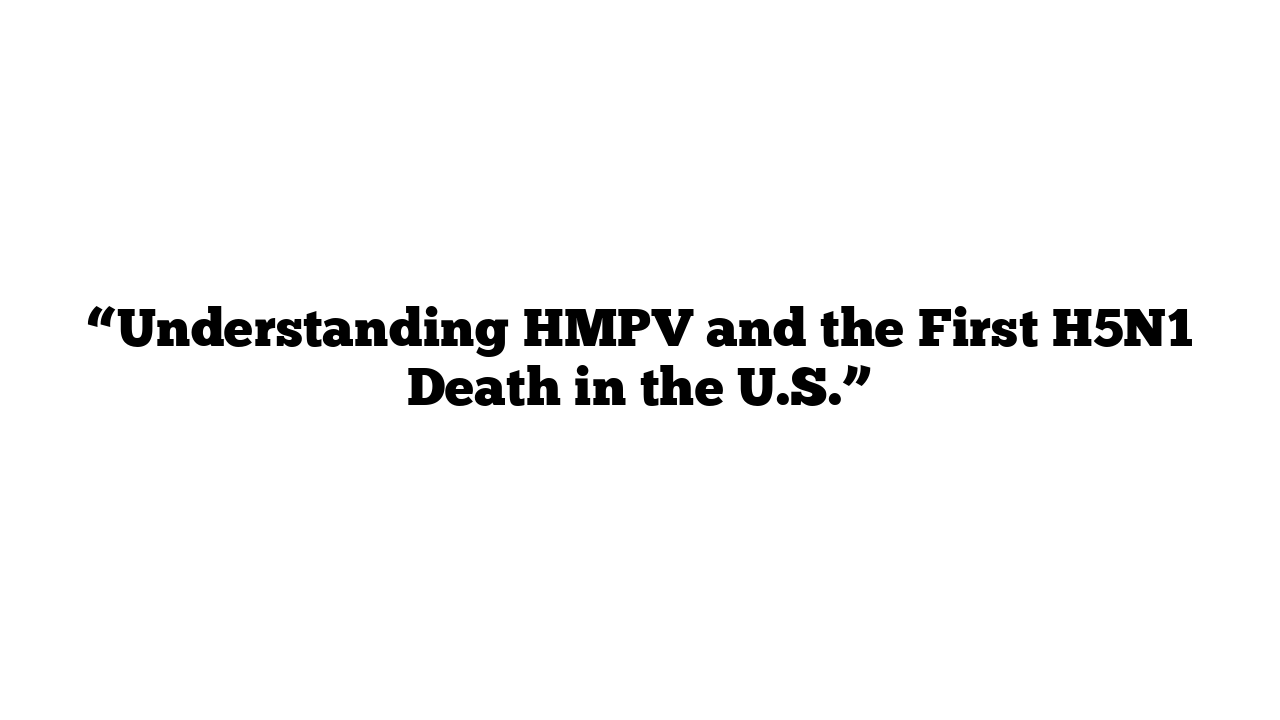What Is HMPV, and How Does It Spread? Insights on the First H5N1 Death in the U.S.
In the world of respiratory illnesses, HMPV (Human Metapneumovirus) and H5N1 (avian influenza) are gaining attention due to their potential risks. While HMPV is a common virus causing respiratory infections, H5N1 is infamous for its severe effects on both birds and humans. With the first reported H5N1 death in the U.S., these health threats are now under closer scrutiny.
This article explains what HMPV and H5N1 are, how they spread, and why they matter.
What Is HMPV?
Human Metapneumovirus (HMPV) is a respiratory virus first identified in 2001. It belongs to the same family as respiratory syncytial virus (RSV) and can infect individuals of all ages.
Key Facts About HMPV:
- Prevalence: HMPV is a leading cause of respiratory illness worldwide.
- Symptoms: It causes mild to severe symptoms, including cough, fever, nasal congestion, and wheezing.
- Risk Groups: Young children, the elderly, and those with weakened immune systems are at higher risk.
How Does HMPV Spread?
Like many respiratory viruses, HMPV spreads through respiratory droplets. When an infected person coughs, sneezes, or talks, the virus can land on surfaces or directly enter the respiratory tract of others.
Modes of Transmission:
- Direct Contact: Touching an infected person or surface contaminated with the virus.
- Airborne Spread: Breathing in droplets expelled by an infected person.
- Touching Contaminated Surfaces: The virus can survive on surfaces for hours, making hand hygiene crucial.
H5N1: The Avian Influenza
H5N1 is a highly pathogenic strain of avian influenza, primarily affecting birds but occasionally infecting humans. While human cases are rare, they are often severe and fatal.
The First H5N1 Death in the U.S.
Recently, the United States reported its first death linked to H5N1. The case involved a person exposed to infected poultry, underscoring the virus’s potential danger to humans.
How Does H5N1 Spread?
H5N1 primarily spreads through birds, but humans can contract it under certain conditions.
Transmission in Birds:
- Birds shed the virus through saliva, nasal secretions, and feces.
- It spreads rapidly in poultry farms, often necessitating mass culling to contain outbreaks.
Human Infection:
- Direct Contact: Handling infected birds or their droppings.
- Inhalation: Breathing in aerosols from contaminated environments.
- Contaminated Food: Eating undercooked poultry or eggs from infected birds.
Comparing HMPV and H5N1
| Aspect | HMPV | H5N1 |
|---|---|---|
| Primary Host | Humans | Birds |
| Transmission | Person-to-person via droplets | Direct contact with infected birds |
| Symptoms | Respiratory illness | Severe flu-like symptoms, organ failure |
| Risk of Pandemic | Low | High with mutations |
Why Is the First H5N1 Death in the U.S. Significant?
The death highlights the need for vigilance against zoonotic diseases. While isolated, this case emphasizes the importance of surveillance and preventive measures.
Lessons to Learn:
- Early Detection: Monitoring outbreaks in birds and humans is essential.
- Public Awareness: Educating people about risks and safety measures can save lives.
- Preparedness: Governments must invest in vaccine development and response plans.
Preventing the Spread of HMPV and H5N1
For HMPV:
- Practice Good Hygiene: Wash hands frequently and avoid touching your face.
- Isolate When Sick: Stay home to prevent spreading the virus.
- Boost Immunity: Maintain a healthy lifestyle to reduce the severity of infections.
For H5N1:
- Handle Poultry Safely: Use gloves and masks when dealing with birds.
- Cook Thoroughly: Ensure poultry and eggs are cooked to safe temperatures.
- Report Sick Birds: Inform authorities about unusual bird deaths.
What Experts Say
Dr. Anthony Fauci, a leading infectious disease expert, has stated:
“The threat of zoonotic diseases like H5N1 underscores the importance of global health preparedness.”
Similarly, public health officials emphasize the need for collaboration and research to address these threats.
Visit medicaltimes.io for more tips and updates on respiratory viruses and health topics.
Top 10 FAQs: HMPV and H5N1
1. What is HMPV?
HMPV is a respiratory virus causing illnesses similar to RSV and the flu.
2. How is HMPV different from the flu?
While both cause respiratory symptoms, HMPV is from a different virus family and is less well-known.
3. Is HMPV dangerous?
For most people, HMPV causes mild symptoms. However, it can be severe for infants, the elderly, and immunocompromised individuals.
4. What is H5N1?
H5N1 is a highly pathogenic avian influenza virus primarily affecting birds but occasionally infecting humans.
5. How did the first H5N1 death in the U.S. occur?
The individual had direct exposure to infected poultry and succumbed to severe complications.
6. Can HMPV and H5N1 become pandemics?
HMPV has a low pandemic risk. H5N1 could become a pandemic if it mutates to spread easily among humans.
7. How can I protect myself from HMPV?
Practice good hygiene, avoid close contact with sick individuals, and maintain strong immunity.
8. Is there a vaccine for H5N1?
Vaccines for H5N1 are under development but not widely available yet.
9. Are there treatments for HMPV?
Treatment involves managing symptoms as there is no specific antiviral for HMPV.
10. Should I avoid eating poultry because of H5N1?
Properly cooked poultry and eggs are safe to eat.
